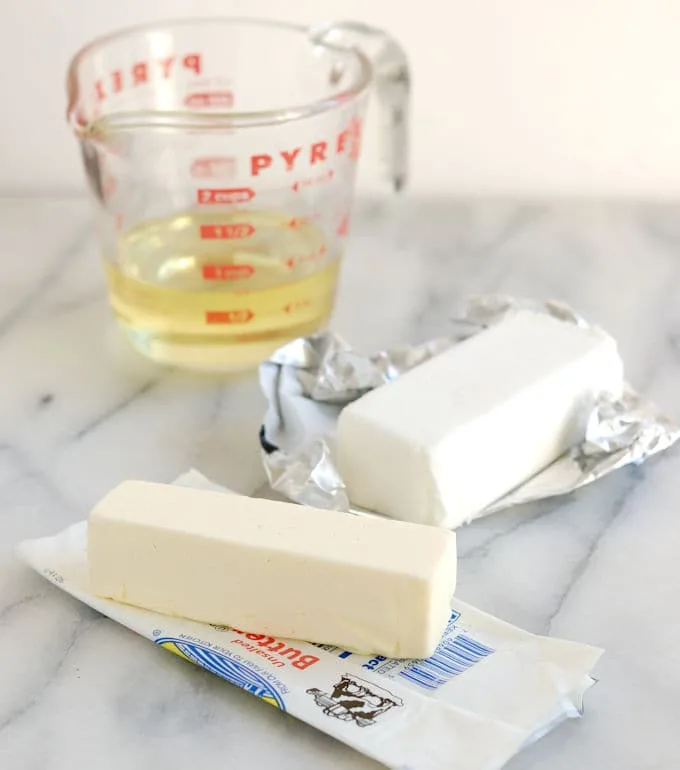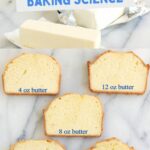🧈 The Science of Fats in Baking
Fats play a crucial role in baking, they tenderize, add richness, carry flavor, and influence structure. Whether it’s the buttery crumb of a pound cake, the flakiness of a pie crust, or the delicate texture of a cookie, fat determines how your baked goods feel and taste.
While trends come and go, from “low-fat” baking to the rise of coconut oil, understanding how each type of fat behaves in the oven gives you control over texture, flavor, and shelf life.
Table of contents

Why Baked Goods Need Fat
Fat gives baked goods tenderness, moisture, and flavor. It works in a few key ways:
- Tenderizing: Fat coats flour proteins, limiting gluten development and producing a softer crumb.
- Flavor & Aroma: Butter and oils carry and enhance flavor compounds.
- Leavening Support: In the creaming method, fat traps air with sugar crystals, forming the structure for rise.
- Moisture Retention: Fats slow staling and help baked goods stay soft longer.
Different types of fat, butter, shortening, and oils, behave differently, so choosing the right one is essential for achieving the texture you want.
Butter in Baking
Butter is about 80% milkfat and 15% water, with the remainder made up of milk solids. Its combination of solid fat crystals and water droplets encased in fat makes it spreadable at room temperature, and perfect for the creaming method, which aerates cake batters and cookie doughs.
Why Butter Works So Well
- Adds unmatched flavor and aroma.
- Provides just enough moisture for tenderness.
- Solid at room temperature, it creates flaky layers in pastry.
Always use unsalted butter when baking so you can control the salt level precisely.
Baking Sense Tip
Room temperature butter creams best with sugar, creating small air pockets that expand during baking for a lighter texture.
Shortening in Baking
Vegetable shortening is made from plant oils that have been hydrogenated or otherwise solidified. It’s a vegan-friendly alternative to butter and has unique properties:
- Creams up lighter than butter because it’s aerated during processing.
- Contains emulsifiers that stabilize batters and allow for more liquid and sugar, producing very tender cakes.
- Has no water content, which can reduce gluten formation even further.
Shortening lacks butter’s flavor, so it’s often used in recipes where texture matters more than taste — like pie crusts or cookies that need to hold their shape.
(Margarine, on the other hand, doesn’t have the same emulsifiers or structure — and lacks the clean flavor of butter. I never use it.)
Vegetable Oil in Baking
Liquid oils coat flour proteins more efficiently than solid fats, resulting in extremely tender, moist crumbs. However, since oil cannot be “creamed,” it doesn’t trap air bubbles so cakes made solely with oil tend to be softer but less fluffy.
Oil-based batters are perfect for:
- Muffins and quick breads – extra moist and tender.
- Chiffon and olive oil cakes – soft, supple texture.
- Yeast doughs and pizza crusts – improved elasticity and crispness.
For best results, some bakers combine oil with butter to balance texture and flavor.
Fat Substitutes in Baking
If you need to reduce fat for dietary reasons, certain fruit purees (applesauce, prune, or pear puree) can replace part or all of the fat in some recipes.
These purees mimic fat’s tenderness and moisture retention but don’t aerate or carry flavor the same way.
- Pros: Moist and tender crumb, lower fat content.
- Cons: Denser texture, less rich flavor.
You’ll recognize the texture if you’ve ever made an applesauce cake, moist and flavorful, but not as light as one made with butter or shortening.
📘 Continue Learning
This page is part of my Baking Ingredient Science series, where I explain how each ingredient affects texture, flavor, and structure in baking.
Explore more ingredient guides:
- Flour in Baking – structure and gluten formation
- Sugar in Baking – sweetness, tenderness, and moisture
- Eggs in Baking – structure and emulsification
- Salt in Baking – balance and control
- Chemical Leavening in Baking – rise and aerate
- Yeast in Baking – fermentation and flavor
- Chocolate in Baking – flavor and structure

